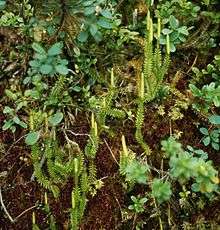Lycopodiaceae
The Lycopodiaceae (class Lycopodiopsida, order Lycopodiales) are an old family of vascular plants, including all of the core clubmosses, comprising 16 accepted genera[2] and about 400 known species.[3] This family originated about 380 million years ago in the early Devonian, though the diversity within the family has been much more recent.[4] "Wolf foot" is another common name for this family due to the resemblance of either the roots or branch tips to a wolf's paw.[5]
| Lycopodiaceae (Clubmosses) | |
|---|---|
 | |
| Spinulum annotinum | |
| Scientific classification | |
| Kingdom: | Plantae |
| Clade: | Tracheophytes |
| Clade: | Lycophytes |
| Class: | Lycopodiopsida |
| Order: | Lycopodiales |
| Family: | Lycopodiaceae P.Beauv. ex Mirb. 1802[1] |
| Genera | |
|
See text | |
Description
Members of Lycopodiaceae are non-flowering and do not produce seeds, and instead they produce spores, which are oily and flammable spores and are the most economically important aspects of these plants. The plants bear their spores on specialized structures at the apex of a shoot called a strobilus (plural: strobili); they resemble a tiny battle club, from which the common name derives. They share a common feature of having a microphyll, which is a "small leaf with a single vein, and not associated with a leaf gap in the central vascular system."[4] In Lycopodiaceae, the microphylls often densely cover the stem in a linear, scale-like, or appressed fashion to the stem, and the leaves are either opposite or spirally arranged. The club mosses commonly grow to be 5-20 cm tall.[4] The gametophytes in most species are non-photosynthetic and myco-heterotrophic, but the subfamily Lycopodielloideae and a few species in the subfamily Huperzioideae have gametophytes with an upper green and photosynthetic part, and a colorless lower part in contact with fungal hyphae.[6][7]
Taxonomy
The family Lycopodiaceae is considered to be basal within the Lycopodiopsida (lycophytes). One hypothesis for the evolutionary relationships involved is shown in the cladogram below.[2]
| Lycopodiopsida |
| ||||||||||||
Within the family, there is support for three subgroups. In 2016, Field et al. proposed that the primary division is between Lycopodielloideae plus Lycopodioideae and the Huperzioideae (names sensu PPG I).[8]
| Lycopodiaceae |
| ||||||||||||
There are about 400 known species in the family Lycopodiaceae.[3] Sources differ in how they group these into genera. Field et al. (2016) say "Most Lycopodiaceae species have been re-classified into different genera several times, leading to uncertainty about their most appropriate generic identification."[8] In the PPG I system, the family has 16 accepted genera, grouped into three subfamilies, Lycopodielloideae, Lycopodioideae and Huperzioideae, based in part on molecular phylogenetic studies. The Huperzioideae differ in producing spores in small lateral structures in the leaf axils,[8] and it has been suggested that they be recognized as a separate family. Other sources use fewer genera; for example, the three genera placed in the subfamily Huperzioideae in PPG I, Huperzia, Phlegmariurus and Phylloglossum, have also all been treated within a broadly defined Huperzia.[8]
The species within this family generally have chromosome counts of n=34. A notable exception are the species in Diphasiastrum, which have counts of n=23.
Genera
The Pteridophyte Phylogeny Group classification of 2016 (PPG I) accepts the following genera, grouped into three subfamilies:[2]
- Subfamily Lycopodielloideae Wagner & Beitel 1992 ex Øllgaard
- Lateristachys Holub
- Lycopodiella Holub
- Palhinhaea Franco & Vasconcellos nom. cons.
- Pseudolycopodiella Holub
- Subfamily Lycopodioideae Eaton sensu Wagner & Beitel ex Øllgaard
- Austrolycopodium Holub
- Dendrolycopodium Haines
- Diphasiastrum Holub
- Diphasium Presl ex Rothmaler
- Lycopodiastrum Holub ex Dixit
- Lycopodium Linnaeus
- Pseudodiphasium Holub
- Pseudolycopodium Holub
- Spinulum Haines
- Subfamily Huperzioideae Rothmaler sensu Wagner & Beitel ex Øllgaard
- Huperzia Bernhardi
- Phlegmariurus Holub
- Phylloglossum Kunze
Distribution and habitat
The members of Lycopodiaceae are terrestrial or epiphytic in habit and are most prevalent in tropical mountain and alpine environments.[4] Though Lycopodiaceae are most abundant in these regions, they are cosmopolitan, excluding arid environments.[9]
Uses
- The running clubmosses (Diphasiastrum) have long been used as greenery for Christmas decoration.
- The spores have long been used as a flash powder. See Lycopodium powder.
- The spores have been used by violin makers for centuries as a pore filler.
- In Cornwall, club mosses gathered during certain lunar phases were historically used as a remedy for eye disease.
References
- James L. Reveal, Indices Nominum Supragenericorum Plantarum Vascularium
- PPG, I (2016). "A community-derived classification for extant lycophytes and ferns". Journal of Systematics and Evolution. 54 (6): 563–603. doi:10.1111/jse.12229.
- Christenhusz, M. J. M. & Byng, J. W. (2016). "The number of known plants species in the world and its annual increase". Phytotaxa. Magnolia Press. 261 (3): 201–217. doi:10.11646/phytotaxa.261.3.1.
- Judd; et al. (2015). Plant Systematics: A Phylogenetic Approach. Sunderland, MA: Sinauer Associates.
- "Lycopodiaceae". www.flora.dempstercountry.org. Retrieved 2017-12-20.
- Mycoheterotrophy: The Biology of Plants Living on Fungi
- Phylogeny of Phlegmariurus (Lycopodiaceae) focusing on Brazilian endemic species
- Field; et al. (January 2016). "Molecular Phylogenetics and the Morphology of the Lycopodiaceae Subfamily Huperzioideae Supports Three Genera: Huperzia, Phlegmariurus and Phylloglossum". Molecular Phylogenetics and Evolution. 94, Part B (Pt B): 635–57. doi:10.1016/j.ympev.2015.09.024. PMID 26493224.
- Øllgaard, B. (1990). "Lycopodiaceae". In Pteridophytes and Gymnosperms: 31–39.
External links
- Thiselton-Dyer, Thomas F. (1889). The Folk-lore of Plants.
- Wagner, W. H. Jr.; Beitel, J. M. (1992). "Generic classification of modern North American Lycopodiaceae". Ann. Missouri Bot. Gard. 79 (3): 676–686. doi:10.2307/2399759. JSTOR 2399759.
- Lycopodiaceae in Flora of North America
| Wikimedia Commons has media related to Lycopodiaceae. |
| Wikispecies has information related to Lycopodiaceae |